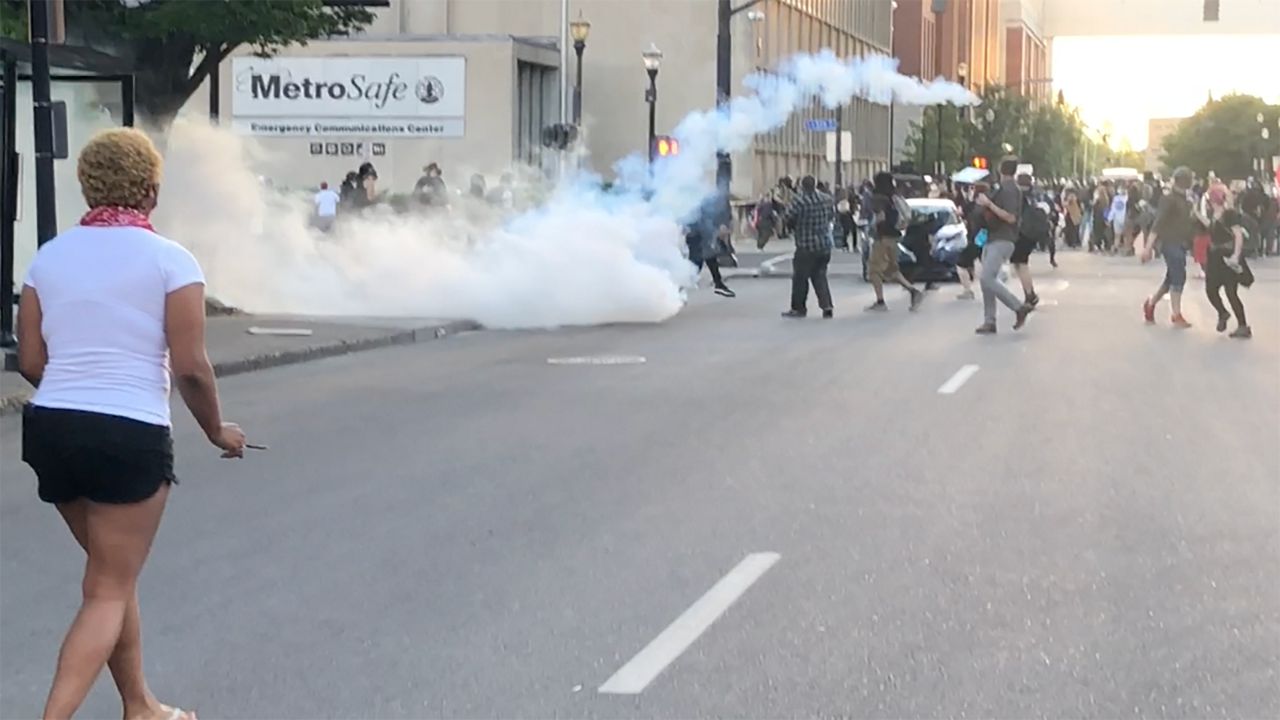LOUISVILLE, Ky. — First, Nicole Aghaaliandastjerdi’s eyes began burning. Difficulty breathing followed. Then came skin irritation, made worse by the mask she wore to protect herself from the coronavirus. Days later, the tear gas she inhaled while protesting in downtown Louisville last May left pain in her chest.
“Those first few days were really bad,” she said.
Like many police forces across the country, the Louisville Metro Police Department (LMPD) used tear gas to disperse crowds during the first weekend of protests against the police killings of Breonna Taylor and George Floyd. Now, Louisville joins cities across the country in having a conversation about whether a weapon banned on the battlefield should be used on American streets.
For Aghaaliandastjerdi, who was part of a group that sued LMPD over its use of chemical weapons in July, the answer is obvious. “Other cities have banned them outright and Louisville needs to do the same,” she said.
On Wednesday, the Louisville Metro Council’s Public Safety Committee discussed a package of police reforms that included a measure limiting LMPD’s ability to use chemical weapons. Councilman Brandon Coan, a co-sponsor of the ordinance, told Spectrum News 1 that such weapons require “special rules because they’re so different from other kinds of weapons.”
The legislation is modeled on recommendations from “8 Can’t Wait,” a national effort to bring eight police reform measures to departments across the county. Along with the tear gas restrictions, the Louisville ordinance would ban chokeholds, require de-escalation, and forbid shooting at or from a moving vehicle.
Most of those rules already exist in LMPD’s standard operating procedures and generated little discussion Wednesday. But the restrictions on chemical weapons, including tear gas, pepper spray, and pepper balls, were more controversial.
Council President David James, a former police officer, said the limitations made him “uneasy.” Councilman Mark Fox, also a former police officer, defended chemical agents as a de-escalation tool that allow officers to avoid using a more severe method of incapacitation.
“Is it uncomfortable? Yes it is,” he said. “But it lasts 15 or 20 minutes. Splash a little water on your face. But there’s no hospitalization required. There’s no injury.”
By the end of the meeting, the section of the ordinance limiting the use of chemical agents “when mitigating civil unrest” was stricken. Councilwoman Jessica Green, Coan’s co-sponsor, said the two members may bring back the restrictions as a separate piece of legislation.
On May 28, the first night of mass protests in Louisville, gunshots rang out among protesters outside Metro Hall. That’s the first time police used tear gas during the current wave of unrest.
"One of the gentlemen out there was not going to survive if we did not get him to the hospital immediately,” LMPD Major Aubrey Gregory told Metro Council earlier this month. Tear gas, he said, was used “in response to that immediate need to go save those people.”
Over the next several days tear gas was used “as a last resort to clear crowds that were presenting a safety issue to the public,” then-interim LMPD chief Robert Schroeder said in June. Louisville’s Public Safety Chief Amy Hess confirmed in a Metro Council hearing that tear gas was used to control “riotous crowds” during the first several days of protest.
LMPD officials say the department has not used tear gas since, though they did use pepper balls in last week’s protests. At Wednesday’s hearing, Coan credited the move away from tear gas to lessons learned this summer, pushback to its use before, and a change to the standard operating procedure made by Schroeder in early June. The policy update, announced on June 10, required the chief or his or her designee to approve the use of tear gas.
But there’s a difference between regulating police action with internal policy and doing so with a city ordinance, said Dr. Deonte Hollowell, Professor of History and African-American studies at Spalding University.
“To have it as a city ordinance, at least puts another system of checks and balances in place that holds police accountable for what they do,” said Hollowell, a member of the Louisville Metro Criminal Justice Commission. “For those who say having it be police policy is enough, I would say, obviously it’s not.”
The calls to regulate the use of tear gas this summer come not just because of the nationwide unrest, but because of the ongoing pandemic. In June, the American Thoracic Society (ATS) called for a moratorium on the use of tear gas. “The use of chemical crowd control agents is outlawed in the time of war,” ATS president Dr. Juan C. Celedón said in a statement. “They cause significant short- and long-term respiratory health injury and likely propagate the spread of viral illnesses, including COVID-19.”
Kate Miller of the ACLU of Kentucky said that even in non-pandemic times, tear gas is a “dangerous tool.”
“It is likely to escalate the situation,” Miller said, and when it's used near residential areas it can affect unintended populations. “You can’t control where tear gas is going to go,” she said.
The ACLU of Kentucky supports the Metro Council ordinance but Miller says it could go further. “Tear gas is serious and it shouldn't be used,” she said. “Prohibit it—full stop.”
Louisville’s attempts to restrict tear gas come as other cities and states are having similar discussions. Those favoring the strictest measures have had trouble getting what they want in those places, too. In Oregon, for example, Gov. Kate Brown signed a bill in June to ban the use of tear gas unless police declare a riot. Hours later, police in Portland declared a riot and used tear gas to disperse the crowd.
